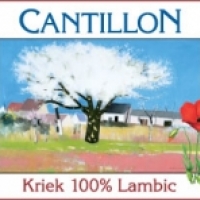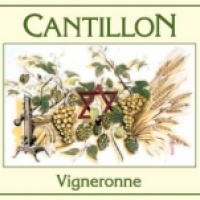Comprar Cantillon Kriek 100% Lambic Bio - Cantillon Vigneronne - Cantillon Grand Cru Bruocsella Lambic Bio



Kriek 100% Lambic Bio
The most famous among the fruit beers is without doubt the Kriek.
On a warm summer day, a lorry coming from the auction at Sint-Truiden delivers 4.000 kgs of fresh Kellery cherries to the brewery. The brewery staff will then put about 150 kgs of fruits in oakwood or chestnutwood barrels which can contain 650 litres of lambic and which have been cleaned some days before.
These barrels are filled with healthy lambics which are more or less one and a half year old. These are not so easy to find, because many beers are still ill at that age. These "oily" beers will have to mature for some months in the main barrel. When the Kriek barrels are filled with the fruits and with the lambic (about 500 litres), the hole in the barrel is closed with a sheet of paper in order to avoid contact with impurities.
Five days later, the fermentation starts. The sugars from the lambic and from the fruits bring about the activity of the yeasts which are concentrated in the wood and in the skin of the fruits. A marvelous pink or red foam decorates the old barrels in the cellar.
Normally, the fermentation stops around the 10th of August. The barrels are then closed and the acid lambic begins to extract the taste and the colour from the fruits. Flies and mosquitoes haunt the cellars and are likely to provoke bad infections. Due to the presence of the home spider, however, a natural predator which is more efficient than any insecticide, the Cantillon Brewery presents a natural equilibrium which enables us to produce our beers.
The fermentation of the Kriek in the bottle generally starts in the beginning of October. Two barrels of Kriek from the first extraction and two from the second are pumped into a huge barrel. (The second extraction is obtained by filling the barrel for a second time in order to extract as much from the fruits as possible). It is also possible to blend a certain quantity of young lambic with the Kriek in order to obtain a second fermentation in the bottle. The Kriek goes through a natural saturation, normally after three to five months in the bottle. We recommend to drink the Kriek within one year after the bottling.
The fermentation will change the primary taste of the product and the Kriek will be dominated by the character of the lambic. The red colour will change into more oily shades. This is, however, a personal point of view. Some customers conserve their Kriek for a long time and like it that way. Kriek is a traditional summer beer. It is a very thirst-quenching beer which tastes deliciously with a big slice of brown bread with white cheese, radishes, onions and chives.
Years ago, people who drank Kriek in a pub were also given two lumps of sugar and a "stoemper" on a small plate. With the "stoemper", the customer could crush the sugar on the bottom of his glass and sweeten it in a natural way in order to eliminate the sour taste.
The lambic brewers weren't only established in the Senne valley, but also in the valley of the Yssche . This small river has its spring in the Forêt de Soignes and flows through villages like Hoeilaart, Overijse and Huldenberg. In this valley there used to live many brewers who made delicious lambic.
They didn't add cherries or raspberries to their beer, but grapes which had been cultivated in greenhouses. By blending muscat grapes and lambic, the brewers and beer merchants produced the "druivenlambik" (grapes lambic).
In 1973, Jean-Pierre Van Roy, after having relaunched successfully the production of raspberry lambic, bought white grapes and soaked them in lambic. This experiment was successful too. The fructose, which abounds in these fruits, enables us to make a beer which is more mellow than the Gueuze or the other fruit beers.
The name Vigneronne Cantillon was given in 1987. This name reminds us that, while it belongs to the beer patrimony, the spontaneous fermentation, the ageing in the barrels for several years and the addition of grapes make it a distant cousin of certain white wines.
In spite of its success, the Vigneronne represents less than 5% of the total production of the Cantillon brewery. In order to obtain grapes which are as mature as possible, we buy them at the end of the season. Every year, 1000 kilos of white italian grapes are delivered at the Cantillon brewery in the beginning of October.
It is difficult to produce more Vigneronne even though the demand exists. All the grapes are picked from the bunch by hand and we don't have much time, since the new brewing season starts at the end of October.
The beers are not blended before the bottling. The second fermentation is caused by the addition of a sugared liquor. The six-pointed star on our label is an alchemist's symbol. It contains four elements, represented by triangles, of the brewing process. The fire is the symbol of the mashing tun, the earth of the cereals, the air of the yeasts, and the water is the fourth element. At this moment, only a brewer of traditional lambic may use this symbol.
Cerveza lámbica madurada durante 3 años en barricas de roble.
- Sesma Almost Kriek - Ceriux Cerveza de Vendimia Tempranillo Blanco - La Piñonera Cerveza de Vendimia 2017
- Dos Equis (XX) Ambar - Bohemia
- Montseny Blat - Montseny Mala Vida Brandy - Against The Grain / Cervesa Del Montseny Jorge Castaña
- Black Bitch Porter - Dust Porter - Duque Porter
- A.K. Damm - Ambar Caesaraugusta - Paulaner Hefe-Weißbier / Hefe-Weizen / Weissbier
- La Sagra Madrí Excepcional - Dawat One-Off Big John Sylver A Long IPA - Dawat Elements Bosque Nórdico
- Amager Christianshavn Pale Ale - Amager / Surly Todd The Axe Man - Amager / La Pirata La Pirata
- Patagonia Abrazo de Oso - Patagonia Bohemian Pilsener - Patagonia Weisse
- Leffe Blonde - Stella Artois - Chimay Première (Red)
- Cerex Cereza - Sevebrau Serona Strong Ale - Belona Special Bitter
- Zulogaarden Biscuit - Benelux / Zulogaarden Catapulte
- Salva Vida - Gallo / Famosa - Monte Carlo Premium
- Grimbergen Blanche - Grimbergen Blonde - Grimbergen Double Ambrée
- Códice Cebada - Dama Alaricana Queimada - Guineu Mr. Petroli
- Anheuser-Busch Bud Light - Coors Light
- Gatgraz Hash - Tag - Gredos Cerveza & Whisky de Malta - La Pedriza Trigo
- Victoria - Grupo Modelo - Quilmes Lieber - Delirium Nocturnum
- Amstel - Warsteiner Dunkel
- Los Bichos Mandan Kriek - Barbarian Chicha Tu Mare
- Brouwerij ’t IJ Zatte - La Chouffe Blonde - Leffe Triple
- Basqueland Arraun Amber Ale - Laugar Hopzale - Bidassoa Basque Brewery Amuitz
- Chimay Première (Red) - Invictus Alquimista - A Cova da Serpe Ruda
- Leffe Blonde - La Corne du Bois des Pendus Triple - Belgo Sapiens P’tit Granit
- Oud Beersel Oude Geuze Vandervelden 135 years - Cantillon Cuvée Saint-Gilloise (Champions)
- O’Hara’s Irish Pale Ale - O’Hara’s Double IPA - O’Hara’s Leann Folláin
- To Øl Baltic Frontier Seabuckthorn IPA - Mikkeller Koppi Coffee IPA Citra X Nano Challa - Mikkeller Creamsicle Friends
- Guinness Original - Paulaner Hefe-Weißbier / Hefe-Weizen / Weissbier - Cerveza Sol
- Mahou Cinco Estrellas - Estrella Galicia Especial - Mahou Maestra
- Magic Rock / Naparbier Modernisme - Camden Gentleman’s Wit
- Tecate - Superior - Cerveza Sol
- Cerex Ibérica de Bellota - Yakka Humo - Saison Ahumada - Piporra Original
- Meiga Nadal - Galician Brew Curuxa Lager - Monte Rei Cebada & Miel
- Mahou Clásica - Mahou San Miguel La Prohibida
- Murex Caña de Azúcar - Murex Ambar - Murex Negra
- DeDues Original Ale - Rosita Original - La Maltista APA
- Paulaner Hefe-Weißbier / Hefe-Weizen / Weissbier - Miller Genuine Draft - La Cabra del Maresme Perla Negra
- Barret Globale - Vikingathor Boris Brew - Sabana Miel
- Cas Cerveser Sant Antoni i el Dimoni - Fundadores Imperial Black IPA - Birbant DR IPA
- Timmermans Kriek Lambicus - Timmermans Framboise Lambicus
- Modelo Reserva Tequila Barrels - Negra Modelo - Corona Extra
- Mahou Clásica - Estrella Damm - Estrella Galicia Especial
- Estrella Galicia 1906 Reserva Especial - La Milnueve - Peroni Nastro Azzurro
- Califa Morena - Barbière Belgian White Ale - Hop Hunters Winter India Pale Lager
- Whym La Mare dels Ous - Keltius Trashno - Villa de Madrid / Boris Brew Ziva
- Casimiro Mahou Cerveza de Trigo - Yria / Medina Ernest & Chus - Fergar Blanca
- Jara Ibérica - Blomberg Barbarroja - Cerex Ibérica de Bellota
- Naparbier Back in Black - St. Peter’s Crafted Black IPA - BrewDog Black Hammer
- Suprema - Regia Extra - Pilsener
- Belle Vue Framboise - Mort Subite Oude Gueuze Lambic - Chapeau Exotic
- Autum’s Ale - Gar&Gar Igeldo - Garagart Hopster Party IPA
- Mahou Cinco Estrellas - Mahou Clásica - Argus Especial
- Cerveza Aguila - Gallo / Famosa - Club Colombia Dorada
- Birra & Blues La Rubia - Warsteiner Premium Pilsener / German Pilsener - Wolfram Rubia
- Iki Ginger - Mongozo Mango
- Cruzcampo Cruzial - Ambar Radler
- Oud Beersel Bersalis Kadet - Abbaye De Bonne Esperance - Brussels Beer Project Red My Lips
- Gabarrera Siete Picos - St. Peter’s Best Bitter - Moor Revival
- Estrella Galicia Pilsen - Estrella de Levante Clásica - Heineken
- Modelo Especial - New Holland Dragon’s Milk - Goose Island Beer Co. 312 Urban Wheat Ale















